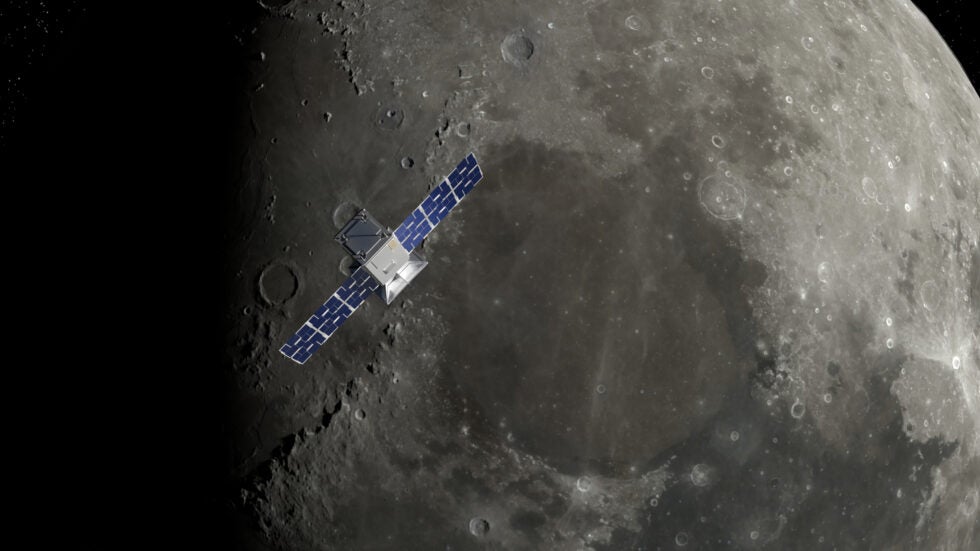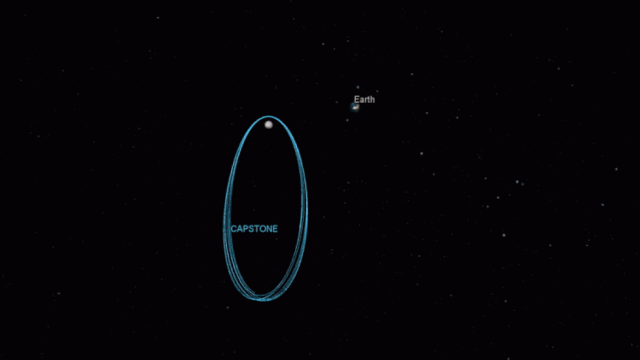NASA’s Artemis program took an important step forward this weekend, with CAPSTONE finally reaching its destination — a near-rectilinear halo orbit (NRHO) around the Moon. The 25 kg cubesat will now test this promising orbit in preparation for the Gateway lunar space station.
CAPSTONE, short for Cislunar Autonomous Positioning System Technology Operations and Navigation Experiment, reached NRHO on Sunday, November 13, according to an Advanced Space press release. Later this week, the $US33 ($46) million cubesat will attempt a pair of tiny clean-up manoeuvres to confirm its placement in the lunar orbit. In addition to being the first human-built device to operate in NRHO, CAPSTONE “is the first CubeSat to fly to and operate at the Moon,” Advanced Space said.

The NASA-funded satellite launched aboard Rocket Lab’s Electron rocket on June 28. Terran Orbital designed and built CAPSTONE, while Advanced Space, with help from Terran Orbital and NASA, is managing the mission.
“The 24/7 shifts have begun and are ready to get through this week’s insertion,” a set of “manoeuvres to make sure we are stable in the orbit,” an Advanced Space spokesperson told Gizmodo in an email. “So far, so good. Today, we celebrate this big milestone.”
CAPSTONE is serving as a scout for NASA’s Artemis program, which seeks to return humans to the Moon later this decade. To support these missions, NASA and its international partners want to place a space station in lunar orbit. The highly elongated NRHO is deemed ideal for spacecraft and space stations because it will require less fuel than standard orbits, while also allowing for constant communications with ground stations on Earth. The CAPSTONE probe will “be able to kick back and rest in a gravitational sweet spot in space — where the pull of gravity from Earth and the Moon interact to allow for a nearly-stable orbit — allowing physics to do most of the work of keeping it in orbit around the Moon,” NASA described.
More on this story: What to Know About Lunar Gateway, NASA’s Future Moon-Orbiting Space Station
CAPSTONE’s 16-minute-long insertion manoeuvre into NRHO began at 11:22 p.m. AEDT on Sunday. A mere 0.44 Newtons of thrust was all that was required for the task, an amount of force equal to the weight of nine sheets of standard printer paper, according to Advanced Space. Following insertion, CAPSTONE indulged in some sunbathing to recharge its batteries. Data received by controllers at 12:00 a.m. AEDT confirmed that CAPSTONE had successfully reached NRHO.
The microwave oven-sized cubesat’s journey to the Moon was not without incident. The third course correction manoeuvre in early September threw CAPSTONE into a tizzy, the result of a partially opened valve on one of its eight thrusters. The satellite went into safe mode and entered into a tumble that prevented it from gathering solar power and properly communicating with mission controllers. Four weeks later, the team transmitted a recovery sequence to CAPSTONE upon diagnosing the problem, putting the mission back on track.
“I’m incredibly proud of the entire CAPSTONE team that has overcome unexpected challenges during the lunar transfer,” Austin Williams, chief technology officer at Terran Orbital, said in a company statement. “The success of this mission is a testament to the rapidly growing commercial space industry. Risk reduction missions like CAPSTONE are aggressive, fast, and forward-leaning with the intent of pushing the state-of-the-art. Unequivocally, the CAPSTONE mission has succeeded in this regard.”
The next step for CAPSTONE, aside from the final clean-up manoeuvres, is to test the CAPS software developed by Advanced Space. CAPS should make it possible for spacecraft to communicate with other spacecraft, reducing the need for ground stations to mediate these sessions. This will become increasingly important as more satellites are sent to the Moon in the coming years, and as NASA and its international partners work to build a sustainable crewed presence in the lunar environment.
More: Satellite Sets New Relay Record for Sending Martian Messages to Earth
